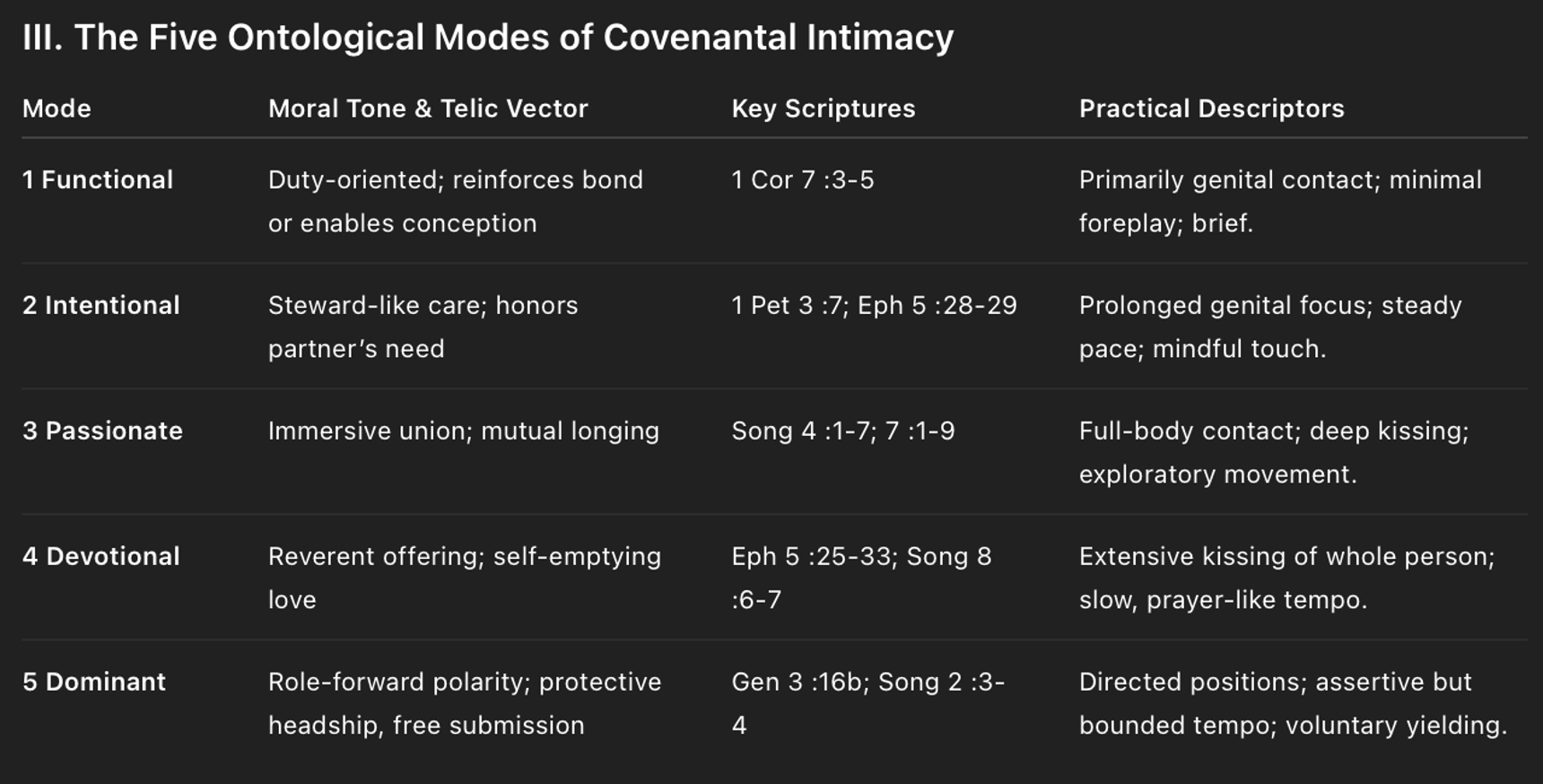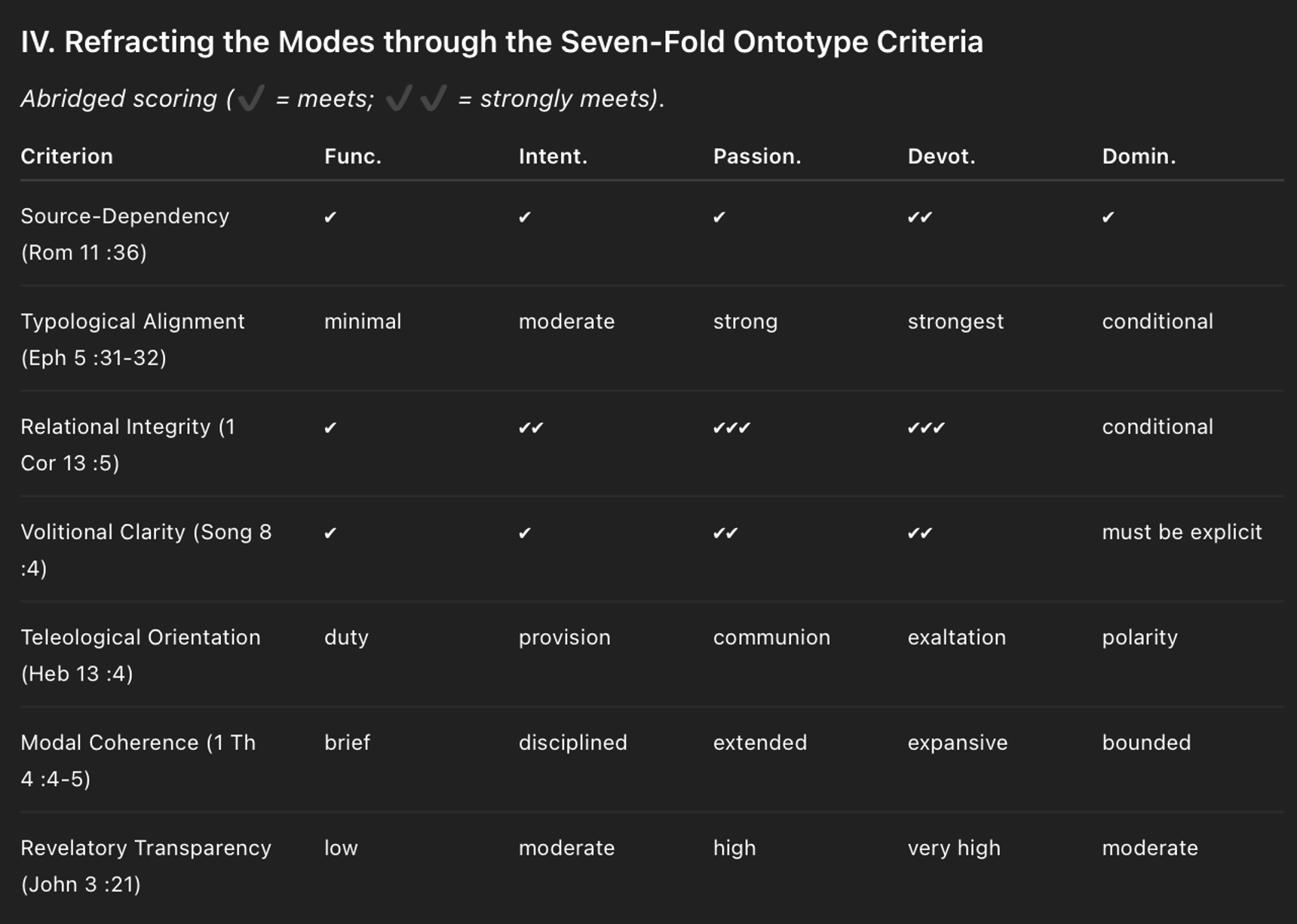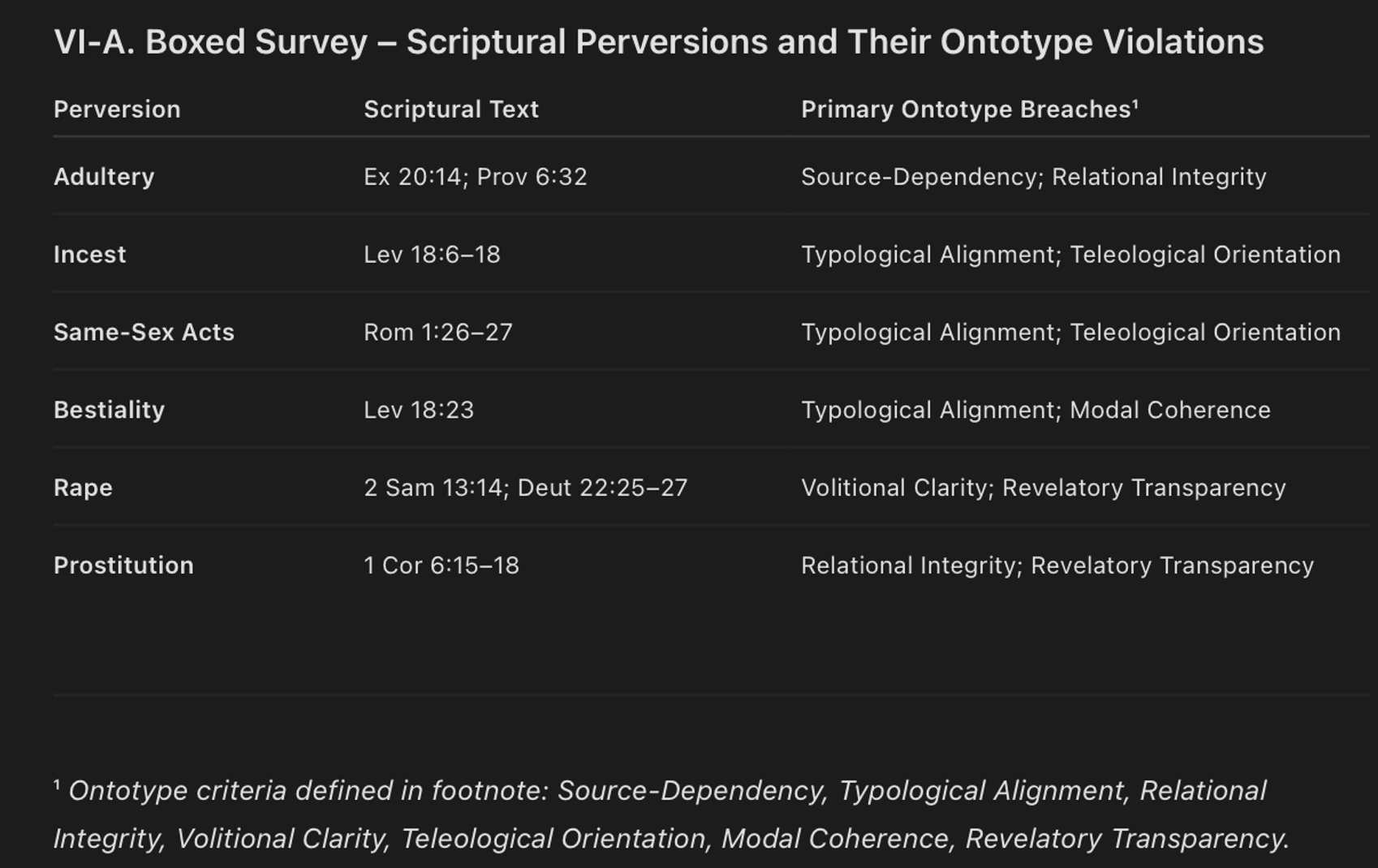Author’s Preface
This section treats eros with reverent sobriety, not sensationalism—because the body, created in the image of God (imago Dei, Gen 1:27), was designed to speak covenantal truth (Gen 2:24; Eph 5:31–32). The joining of man and woman in marriage is not a biological accident but a divinely instituted sign—a mystery that “speaks concerning Christ and the church” (Eph 5:32). The body, therefore, is not morally neutral; it is a vessel of revelation (1 Cor 6:19–20).
This reflection arises primarily from a male vantage point. The language of covenantal polarity, the five erotic modes, and their descriptive emphasis emerge from that posture. Yet Scripture affirms that both male and female reflect the divine image (Gen 1:27), and that honour within the marriage covenant is mutual, not one-sided (1 Pet 3:7). Where the male voice leads in this analysis, it does so with the recognition that the female voice is equally vital in participation, meaning, and covenantal expression.
This model does not aim to assert male priority, but to articulate biblical mutuality—ordered not by hierarchy of value, but by a rhythm of giving and receiving (Eph 5:21–33). Every observation and proposed framework is offered in the spirit of reverence and submission to Scripture, and as a contribution to the shared pursuit of marital holiness, joy, and truth.
The Bible treats sexual union as far more than biological release; it is a “speech-act of covenant.” When a husband and wife “become one flesh” (Gen 2 :24), their bodies utter truths—or lies—about God’s design for relational fidelity (Heb 13 :4). In every encounter they either reveal divine generosity (e.g., a slow, reverent caress that communicates “I receive you as gift”) or conceal it (e.g., a hurried act performed simply to scratch a personal itch). To discern those differences, this appendix employs a seven-fold ontological diagnostic grid^—Source-Dependency, Typological Alignment, Relational Integrity, Volitional Clarity, Teleological Orientation, Modal Coherence, and Revelatory Transparency—showing how each valid erotic posture satisfies or strains those criteria. By mapping intimacy along that framework we reclaim eros not as private recreation but as embodied theology: a covenantal language that must be spoken truthfully or not at all.
^See Ontology Part II for a formal discussion of this model.
In the garden of Eden, sexual union was neither taboo nor trivial. It was ontologically ordered—a transparent act of mutual self-giving, conducted without shame and without spectators. “And they were both naked, the man and his wife, and were not ashamed” (Gen 2:25). This lack of shame was not the absence of privacy, but the absence of guilt. Even in perfection, intimacy was concealed from all but the two covenantal participants. There was no external gaze; no third party had access—visually or imaginatively—to what was enacted as sacred.
This is supported not only by the biblical narrative but also by early Christian reflection. Irenaeus, for example, understood Edenic union as holy and undefiled, grounded in relational order and divine image-bearing (cf. Against Heresies, 4.37.6). The Church Fathers widely affirmed that the marital act, rightly ordered, was part of God's original blessing—not a later concession.
Importantly, Edenic eros was not modesty born of sin, but glory clothed in innocence. Some interpreters, drawing from Psalm 104:2 (“who coverest thyself with light as with a garment”), have suggested that Adam and Eve were originally clothed in light—a radiant covering reflective of divine favour. Their nakedness was thus not exposed in the modern sense; it was disclosed only to each other and to God, without fragmentation or concealment. After the Fall, that spiritual radiance departed. The hastily sewn fig leaves (Gen 3:7) symbolised the loss of internal integrity. God’s replacement of those with garments of skin (Gen 3:21) was not merely practical—it was symbolic: covering as mercy, but also as judgment (and also foreshadowed sacrificial atonement—the first death implied in Scripture, and a precursor to substitutionary covering.)
Thus, privacy preceded shame—not as a reaction to guilt, but as a design feature of intimacy. What was sacred was shielded. What was given was mutual. And what was witnessed was limited to covenantal eyes alone. Any later concept of intimacy that invites or permits a third-party gaze—whether literal or digital—must reckon with this Edenic pattern: union was unveiled only within the bounds of a divinely sealed trust.
Covenantal eros does not unfold as an undifferentiated blur; it moves along a spectrum of morally valid postures that differ in tone, purpose, and degree of disclosure. Each mode can be recognised by the telic question it answers—Why are we doing this now?—and by the quality of presence it demands.
1. Functional
When intimacy serves chiefly to reinforce the marital bond or to pursue conception, husband and wife enter the functional mode. The contact is brief, largely genital, and governed by duty rather than heightened emotion (1 Cor 7 :3-5). Nothing here is shameful and functional can still be affectionate: the act meets its purpose, fulfils mutual obligation, and honours the body as a vessel of procreation or simple reassurance. Yet it offers only minimal relational transparency; hearts and bodies touch just long enough to “render due benevolence” and then withdraw.
2. Intentional (Functional-Plus)
Intentional intimacy grows out of stewardship. Time is still measured, but the giving is deliberate, the pace considerate, the aim compassionate (1 Pet 3 :7; Eph 5 :28-29). The husband may linger to ensure his wife is satisfied; the wife may receive gladly, knowing the act is a gift, not mere necessity. Genital focus remains primary, yet prolonged caress, verbal affirmation, or prayer can lend warmth. Here eros becomes a practiced craft: not ecstatic, but lovingly competent.
3. Passionate
Passionate union answers the cry of longing celebrated throughout the Song of Songs (e.g., 4:1-7; 7 :1-9). Bodies press from head to toe; mouths, hands, and movement explore every contour. Breath quickens, conversation fades into sighs, and mutual desire crests in immersive rhythm. Because passion still abides within covenant, it amplifies—rather than eclipses—respect. Relational integrity is high; each partner “belongs” to the other in a way that both guards and gratifies (Song 6 :3).
4. Devotional
Devotional intimacy reaches for worship. Touch slows; kisses become something akin to blessing; the marriage bed turns into a small sanctuary. The husband loves “as Christ loved the church” (Eph 5 :25-33), offering presence more than performance. The wife yields, not from weakness, but from holy trust. Every gesture says, “I receive you as covenant gift and return myself in kind.” Physical communion now signals spiritual reality: two temples of the Spirit open their doors, unveiling glory without shame (Song 8 :6-7).
5. Dominant
Dominant mode magnifies covenantal polarity. One partner—typically the husband—guides the pace and positions; the other consents to follow. The energy is assertive yet contained: headship enacted, not imposed (Gen 3 :16b; Song 2 :3-4). Directional commands, firmer grip, or role-specific words (“Let me lead—yield to me”) can sharpen erotic focus. This mode is permissible only when voluntary dignity remains intact; and mutual after-care returns to parity. The moment power ceases to protect and to honour. Dominance devolves into domination and exits the covenantal spectrum.
These five modes, though described distinctly, do not operate in sealed compartments. In real union, they blend and oscillate, with each foregrounding a different moral center—presence, pursuit, protection, reverence, or pleasure. But all draw from the same underlying reservoir of trust, vulnerability, and covenantal intent. Intimacy, like music, shifts key without breaking harmony. What matters is not the strict form, but the integrity of the posture, the consent of the offering, and the purity of the telos. This is not a taxonomy of technique, but a grammar of covenantal love.
Together, these five modes trace an arc from minimal disclosure (Functional) to maximal unveiling (Devotional), with Dominant standing not at the far end but on a parallel axis—legitimate only while consent and covenant hold it in check.

When each erotic posture is held up to the seven ontotype touchstones—Source-Dependency, Typological Alignment, Relational Integrity, Volitional Clarity, Teleological Orientation, Modal Coherence, and Revelatory Transparency—an instructive gradient emerges.
Functional sex meets the criteria sparsely. It respects God as the giver of marriage (Source-Dependency, Rom 11 :36) and honours the spouse’s conjugal right (1 Cor 7 :3-5), yet it offers minimal typological depth and very little revelatory openness; the act is completed responsibly but briefly.
Intentional (or functional-plus) intimacy steps further. Deliberate care for a partner’s well-being displays stronger relational integrity and a clearer teleology of provision (1 Pet 3 :7; Eph 5 :28-29). Although still measured, its self-donative pace raises both modal coherence and transparency.
Passionate intimacy ascends to high compliance on nearly every axis. The full-body engagement exalted in the Song of Songs (4 :1-7; 7 :1-9) deepens typological alignment, intensifies relational integrity, and invites a high degree of revelatory vulnerability. Mutual longing here is neither chaotic nor self-regarding, but covenantally ordered.
Devotional union fulfills the criteria at their zenith. It mirrors Christ’s self-giving love for the Church (Eph 5 :25-33), embodying source-dependency at its purest. Every touch becomes an offering; volitional clarity is unquestioned and teleology rises from mere communion to worship. Revelatory transparency is maximal: two souls stand unhidden before God and one another.
Dominant mode is legitimate only when covenantal polarity is freely embraced. If the leader’s assertiveness remains protective and the follower’s yielding is willing, typological alignment (headship and response) is honoured and volitional clarity maintained (Song 2 :3-4; Gen 3 :16b). Yet dominance must stay within strict modal limits lest it degrade into coercion; its moral acceptability is therefore conditional rather than guaranteed (e.g., must never impair the partner’s bodily agency).
In short, the five modes form a moral spectrum from minimal disclosure (Functional) to sacred unveiling (Devotional). Dominant stands to the side, admissible only under covenantal guardrails; outside those rails, it collapses into misuse.

Axiom: Observation that outlives instruction becomes intrusion (Matt 5 :28).
Watching a believer pray may teach posture and language, yet one must finally address God personally to pray. Likewise, verbal description of covenantal intimacy can prepare engaged couples, but peering into another couple’s union for arousal or curiosity seizes disclosure never offered.
While covenantal intimacy belongs exclusively to husband and wife, exposure itself is not the ultimate determiner of sin. Scripture locates transgression not in the event of seeing but in the reorientation of the heart toward acquisitive desire(Matt 5:28). The boundary is therefore not optical but ontological.
A believer may witness or evaluate sexual imagery without corruption if covenantal posture remains intact—just as one may observe violence, deceit, or idolatry (in Scripture or in culture) without participating in them. What defiles is not the sensory form but the transformative pull of misaligned desire. Pornography becomes trespass not merely because it displays bodies but because it trains the will into a covenantless horizon of pleasure without presence, access without responsibility, gaze without gift.
Thus the danger of pornography lies not chiefly in the explicitness of its images but in its formation of the viewer. Its architecture seeks to shape desire away from the embodied, first-person mutuality of covenantal love and toward a disembodied acquisitiveness. It attempts to reshape the seer, not merely stimulate the senses. In this respect, it imitates the serpent’s method: offering sight that promises knowledge but delivers disintegration (Gen 3:6–7).
By contrast, the faithful may evaluate even explicit stimuli without contamination when posture remains governed by covenantal fidelity and gratitude for God’s design. The issue is not exposure but allegiance; not visibility but volition; not the presence of an image but the direction of transformation it is permitted to exercise over the heart.
Pornography is not condemned merely for its explicitness; it is condemned because it voids every ontotype criterion simultaneously. The acts portrayed may be consensual for the performers, yet the viewer remains an uninvited outsider. He or she receives bodily disclosure that was never offered, contributes no presence, assumes no risk, and shoulders no covenantal duty. Even if the performers consent to the act being filmed and shared, that consent does not extend ontologically to every viewer; the moral bond that makes such exposure meaningful is absent. Pleasure becomes theft. In the biblical moral economy, such appropriation fits Paul’s indictment: “But fornication, and all uncleanness… let it not be once named among you” (Eph 5:3–4). The verdict follows plainly: the viewer has no business being there. It is not just moral failure—it is a total eclipse of covenant, presence, and type.
To further clarify this moral structure, Scripture provides a catalogue of sexual perversions—not to sensationalise them, but to show where ontological integrity collapses. These are not arbitrary prohibitions but illustrations of how eros, when torn from covenant, becomes self-parody.
Adultery (Ex 20:14; Prov 6:32) breaches relational integrity by inserting a third party into a bond God calls “one flesh.”
Incest and bestiality (Lev 18:6–18, 23) shatter typological alignment and teleological orientation; the bodies involved cannot signify covenant.
Same-sex acts (Rom 1:26–27) are described as “against nature,” inverting the male–female typology that marriage was designed to reveal (Eph 5:31–32).
Rape (Deut 22:25–27; 2 Sam 13:14) nullifies volitional clarity and converts eros into brute violation.
Commercialised sex—whether temple prostitution (1 Cor 6:15–18) or modern pornography—reduces persons to consumable signs, severing source-dependency and erasing revelatory transparency.
All these acts—however socially normalised—share a single ontological structure: they simulate covenantal union while rejecting covenantal responsibility. They do not merely violate a moral rule; they falsify the very speech-act of the body, counterfeiting the meaning eros was created to declare.
By contrast, the five covenantal modes—when disciplined by scriptural and ontotypic bounds—preserve sexual intimacy as a truthful declaration of divine generosity, human dignity, and mutual delight. What is shared is not simply pleasure, but presence. And what is given is not merely access, but honour.

Each of these practices simulates the form of erotic union while voiding its substance. They may involve bodies, but they do not involve covenant. They may offer pleasure, but not presence. They may enact intensity, but not integrity.
Thus, they are not simply “sins of excess” but ontological trespasses—parodies of what the body was designed to say when rightly joined in marriage.
These perversions all share a common thread: they dislocate eros from its covenantal horizon by distorting what it points to and how it is entered. Yet pornography adds another layer of distortion, not only in content but in perspective. Its very vantage point carries an ontological flaw that makes intimacy impossible on its own terms.
Beneath its moral distortions, pornography carries a more hidden defect: a perspectival flaw. Its power to stimulate is not only in what it depicts but in the vantage point from which it is consumed. Pornography is architected for the third person — the voyeur’s eye, the spectator who sees all angles and holds an impossible vantage. By contrast, intimacy can never be lived from that angle. It is irreducibly first-person: embodied, partial, limited, and mutual.
This perspectival mismatch renders pornography structurally incapable of serving as a stimulus for covenantal eros. The brain grows accustomed to arousal patterns tied to the omniscient camera, but those patterns cannot transfer into the embodied horizon of two human eyes meeting in trust. Addiction forms not only through novelty-seeking but through habituation to a vantage point that intimacy itself cannot reproduce. The result is inevitable disappointment: reality feels “less than,” not because intimacy is deficient, but because the stimulus trained desire to expect what only voyeurism can supply.
Here pornography reveals its ontological trespass with unusual clarity. It does not merely exaggerate, distort, or objectify; it conditions desire to a non-existent perspective, binding eros to a view that is never ours to live. This is a form of pseudo-instantiation — a fraudulent projection of intimacy that simulates presence while severing it from embodiment. Escalation into more extreme content follows naturally, not because desire is insatiable in itself, but because the architecture of voyeurism can never deliver the fulfillment that only relational participation provides.
Thus the flaw is not only moral but structural. No reform of content, moderation of excess, or diversification of representation can resolve it. Pornography arouses through the wrong ontology of sight: the all-seeing third person, rather than the covenantal first person. And in so doing, it dislocates eros from the only ground on which it can be true — embodied, mutual presence under the light of God.
Once eros is displaced from its covenantal vantage, modesty itself becomes distorted, shifting from a guard of intimacy into a cover for shame. This transition marks the fall from perspective to concealment, which Scripture describes in the movement from Edenic nakedness to post-fall hiding.
After Eden’s rupture, unmediated nakedness became perilous (Gen 3 :7). Modesty now guards disordered desire, shielding participants from objectification and outsiders from trespass (1 Th 4 :3-5; Rev 3 :18). Privacy is thus ontological containment, not prudish concealment.
Eros, in Scripture, is not a private appetite but a covenantal language through which the body speaks truth. Within marriage, sexual union becomes revelation: the husband and wife unveil themselves in mutual trust, blessing, and delight; their bodies declare generosity, interdependence, and covenantal fidelity (Prov 5:18–19; Song 6:3; Eph 5:25–33). Intimacy here is not merely permitted—it is sanctified. It forms the soul toward self-giving love, aligns desire with divine order, and embodies the mystery of Christ and His church (Eph 5:32).
Pornography, by contrast, is not condemned because it depicts bodies or because it stimulates the senses. It is condemned because it seeks to reshape desire into a covenantless ontology. It trains the viewer to pursue pleasure without presence, access without gift, gaze without responsibility. Its power is not merely explicitness but formation: it attempts to reorient the heart away from relational reciprocity and toward acquisitive, disembodied consumption.
The problem is therefore not exposure per se, but transformation. Jesus locates sin not in the eye but in the reorientation of the heart (Matt 5:28). What corrupts is not the visibility of the image but the allegiance it demands. And pornography demands allegiance to an erotic universe that marriage was never designed to express. It conditions desire to an impossible vantage point—the omniscient third-person gaze—and habituates eros to a model of intimacy that embodies no covenant, involves no risk, and offers no mutual presence. This perspectival flaw renders pornography structurally incapable of forming covenantal love. It can only deform.
Thus eros bifurcates along an ontological line: Covenantal eros forms. Pornographic eros deforms.
One unveils glory; the other manufactures appetite. One reveals the self; the other fractures the self. One nourishes relational integrity; the other trains relational absence.
The sacredness of union lies not in its secrecy but in its orientation toward truth. The danger of pornography lies not in its explicitness but in its simulation of intimacy without covenant, presence, or gift. Its entire architecture is a counterfeit sacrament—an anti-formation that hollows the meaning the body was created to proclaim.
Let us therefore steward desire in the light of covenant, where eros becomes a truthful declaration of divine generosity, mutual honour, and holy joy (1 John 1:7). And let us refuse the shadows where persons become props, appetite replaces affection, and the gaze is severed from the gift of self. In the covenant of marriage, the body becomes a holy of holies. Outside of it, eros either returns to truth—or collapses into parody. The choice is always one of alignment.
Footnotes
1. The seven criteria correspond to Source-Dependency (Rom 11 :36), Typological Alignment (Eph 5 :31-32), Relational Integrity (1 Cor 13 :5), Volitional Clarity (Song 8 :4), Teleological Orientation (Heb 13 :4), Modal Coherence (1 Th 4 :4-5), and Revelatory Transparency (John 3 :21).
Ontotype Breaches: Each listed perversion disables at least two criteria; many annul all seven.
